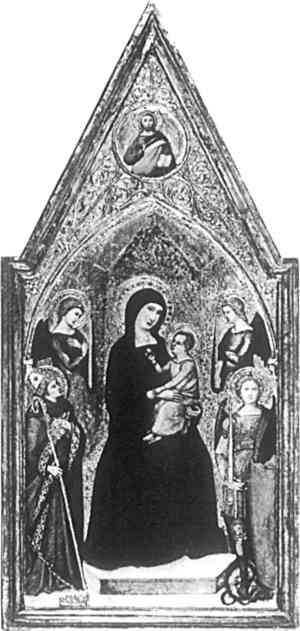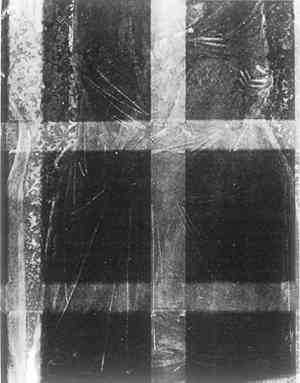THREE METHODS OF MODELLING THE VIRGIN'S MANTLE IN EARLY ITALIAN PAINTINGNorman E. Muller
3 THE TWO-VALUE SYSTEM OF MODELLINGEqually as common as the technique mentioned above was the abbreviated method Cennino carefully described for fresco technique in Chapter LXXXIII and which he briefly noted in Chapter CXLVI as an alternative method of shading in three values. As with the three-value system of modelling, the artist first prepared a carefully shaded drawing on the gesso. Then with a stylus he incised lines in the gesso along the major folds of the drapery. This technique, similar in fashion to the cartoon incisions found on some fifteenth century panel paintings,6 was used to preserve the main outline of the underdrawing from the obscuring effects that followed.7 At this point there were certain variations in the system. In a small panel by Meo da Siena in the Worcester Art Museum, and in the “Benson” Madonna and Child by Lippo Memmi in the National Gallery of Art, Washington, an even layer of dense paint was applied over the gesso before the blue egg tempera paint was brushed on. X-radiographs of these paintings revealed a density to the mantles that could not be explained by the blue pigments being used.8 Perhaps the artists brushed on a grey or red wash over the gesso, the primary constituent being lead white, simulating the technique that is found in many Trecento fresco paintings. Beneath the azurite blues applied a secco on Simone Martini's fresco cycle in the St. Martin Chapel of San Francesco at Assisi, grey and red washes are found where the blue has flaked off. While no one has attempted to explain the function of these washes9, they evidently served a purpose since they are restricted to the blues. The most reasonable explanation is that the translucent blues, azurite and ultramarine, served much like the colored grounds in later Venetian painting in that some light would be transmitted through the crystal grains and reflect off the ground. The resultant wave length of light as perceived by the eye would be registered as alterations in hue. Consequently, the reddish ground would cause a slight shift to the lower end of the light spectrum, whereas the grey would, one presumes, result in a deeper saturation of the blue. A modification of this method was practiced by Luca di Tomm�, a late fourteenth century Sienese artist who, in a painting of the Madonna and Child with Saints Louis of Toulouse and Michael in the Los Angeles County Museum of Art, as shown in Figure 2, modelled his folds with a lead white based grey paint applied over the underdrawing. Some of this paint collected in the incised lines inscribed in the gesso, which accounts for the density of these lines on the X-radiograph of the painting, as shown in Figure 3.10 From a study of numerous X-radiographs of early Italian paintings, not all artists practiced these two techniques, however.11
A flat wash of pure ultramarine blue or azurite egg tempera paint was next brushed over the entire area reserved for the mantle. As strange as this may seem, the carefully executed underdrawing was not purposeless, for the drawing enabled the artist to arrange the folds of the mantle in a way that would accurately reveal the structure of the body underneath. Moreover, the artist probably had a preliminary sketch at hand, which he could use as a guide when the time came to model the folds.12 The shallow depressions of the incisions remained after these steps were completed, and the artist then laid in the shadows with a dark paint consisting of a mixture of black and indigo,13 using the incisions as a guide. Most paintings in which this two-value system was practiced have suffered from abrasion of the surface layers, as seen in Luca di Tomme's painting, as shown in Figure 2, or a combination of abrasion and darkening of the azurite blue layer. Where azurite was used, accumulated darkened varnish in the voids surrounding the mineral grains have contributed to the flat, dark blue-blacks conservators often encounter when treating paintings from the Trecento and Quattrocento. Not all paintings are so disfigured, however. Examples in which the salient details have been preserved from harsh abrasion in the past, are a beautifully preserved Trinity by Nardo di Cione in the Accademia, Florence,14 and a Crucifixion by the same artist in the Uffizi, Florence.15 A careful study of these paintings is worth more than several readings of Cennino's treatise. |

